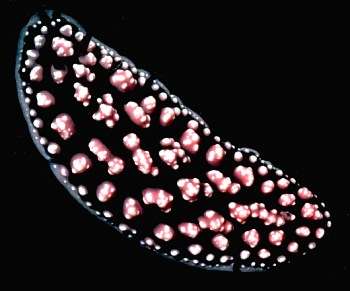
Phyllidiopsis burni
Brunckhorst, 1993
Order: NUDIBRANCHIA
Suborder: DORIDINA
Family: Phyllidiidae
DISTRIBUTION
Most specimens have been collected from Micronesia. There is one record from the northern Great Barrier Reef, and one record from Papua New Guinea.
PHOTO
22 m depth, "sponge mound", Apra Harbour, Guam, 5 July 1988, dorsal view of 61 mm specimen (Brunckhorst, 1993: Plate 9B). PHOTO: D.J. Brunckhorst.
Notes compiled from Brunckhorst, 1993:
Characteristic external features of Phyllidiopsis burni include: the tapering of the body anteriorly and posteriorly; deep pink, acute, multicompound tubercles (oblong in shape medially); smooth, translucent pink mantle edge; black rhinophores with 17-20 lamellae on the clavus (specimens greater than 32 mm); dark grey to black gills; grey foot with pink edge; and large, oval, oral tentacles with deep, long, dark grey lateral grooves.
The black background coloration of the dorsum, deep pink tubercles, black rhinophores (and fewer lamellae to the rhinophoral clavus) of the present species distinguish it from Phyllidiopsis pipeki and Phyllidiopsis krempfi (both possess a pink background and pink and black rhinophores). Phyllidiopsis fissuratus is closer to the present species, but it differs in having very tall, pale pink tubercles with deep, black lined valleys. It has pink rhinophores with a black posterior stripe and 29-32 lamellae on the rhinophoral clavus. Phyllidiopsis fissuratus also has translucent pink rims to the rhinophoral pockets and a very tall, smooth, translucent pink anal papilla (both absent in P. burni), and uniformly pink, square shaped oral tentacles (oval with dark grey lateral grooves in P. burni).
Reference:
• Brunckhorst, D.J. (1993) The systematics and phylogeny of Phyllidiid Nudibranchs (Doridoidea). Records of the Australian Museum, Supplement 16: 1-107.
Rudman, W.B., 1999 (August 1) Phyllidiopsis burni Brunckhorst, 1993. [In] Sea Slug Forum. Australian Museum, Sydney. Available from http://www.seaslugforum.net/find/phylburn
Related messages
Phyllidiella cooraburrama? from Papua New Guinea
November 30, 2002
From: Richard Harris
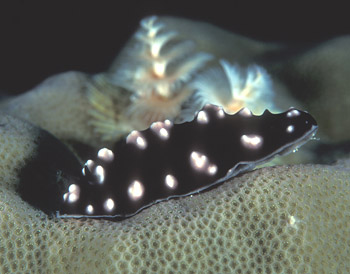
Hi there,
I came across a photo of Phyllidiella cooraburrama on Des Paroz's site and recalled one I also took in Kimbe Bay, Papua new Guinea this July. I think is the same species?? I may be guilty of placing the nudibranch on the hard coral pictured, I cannot recall. I note from your site that this species had not often been observed, so thought it may be of interest.
Any thought appreciated.
Thanks,
Richard Harris
harryh@bigpond.net.au
Harris, R., 2002 (Nov 30) Phyllidiella cooraburrama? from Papua New Guinea. [Message in] Sea Slug Forum. Australian Museum, Sydney. Available from http://www.seaslugforum.net/find/8496Dear Richard,
Thanks for this photo. It sent me back to Des Paroz's messages [message 1, message 2], where I suggested his animal might be Phyllidiella cooraburrama. I also note that Neville Coleman's 1001 Nudibranchs has this identified as Phyllidiella nigra. Identifying phyllidiids just from photos is a bit risky as often the essential characters are on the underside of the animal or in fact inside it. Also, we know so little about colour variation in most species, that deciding whether colour differences mean different species is not a very 'scientific' exercise.
Both P. nigra and P. cooraburrama are good guesses for this species but in Brunckhorst's monograph he specifically states that neither of these species has a 'pale edge to the mantle' and yet your photo clearly shows a continuous pinkish edge. There is a third species which fits this colour and tubercle pattern quite well and that is Phyllidiopsis burni. Brunckhorst specifically describes 'edge of mantle is very thin, smooth and translucent pink'. He also also states that the body is 'more acutely tapered than other phyllidiids'. Although this is difficult to quantify, your animal is quite pointed at each end.
I think your animal is Phyllidiopsis burni. And I suspect Des Paroz's is as well. You mention you may have placed the animal on the
Best wishes,
Bill Rudman
Phyllidiopsis burni? from Thailand.
September 18, 2002
From: Richard Houghton
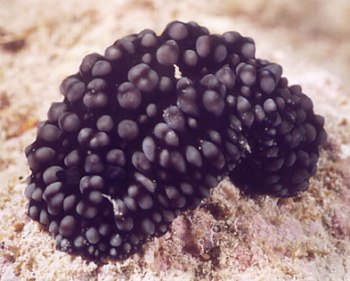
I think this is Phyllidiella pustulosa.
About 4cm long in 50cm of water right off Chaweng Beach, Koh Samui, Thailand, July 2002.
Best regards,
Rich
richard_houghton@hotmail.com
Houghton, R., 2002 (Sep 18) Phyllidiopsis burni? from Thailand.. [Message in] Sea Slug Forum. Australian Museum, Sydney. Available from http://www.seaslugforum.net/find/7854Dear Rich,
Spme phyllidiids are impossible to accurately identify without more information on their underside and their external and internal anatomy. This could be either a greenish form of Phyllidiella nigra or Phyllidiopsis burni. On balance I waver towards Phyllidiopsis burni, mainly because the tubercles are broad based and often compound.
Best wishes,
Bill Rudman
Phyllidiopsis burni from the Solomons
July 8, 2002
From: Rachel Murphy
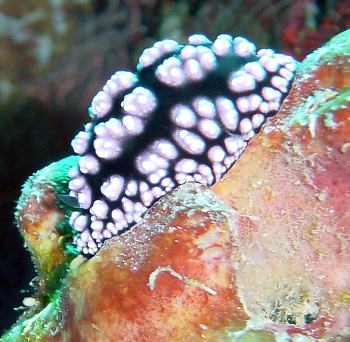
Hi Bill
Here is another phyllidiid from my recent trip to the Solomon Islands. Is this also Phyllidiella pustulosa.
The Gap (out), Gizo, Solomon Is, 19 April 2002, 28m, 29C
Thanks
Rachel Murphy
nudinut@hotmail.com
Murphy, R., 2002 (Jul 8) Phyllidiopsis burni from the Solomons. [Message in] Sea Slug Forum. Australian Museum, Sydney. Available from http://www.seaslugforum.net/find/7451Dear Rachel,
I guess this is a bit of a lesson about phyllidiids. Of the three you thought were Phyllidiella pustulosa, the first was that species, the second was Phyllidiella cf. annulata and this one is Phyllidiopsis burni, a species which can be recognised by the scattered compound pink tubercles on the black mantle and the thin pink edge to the mantle. I suspect this animal is feeding on the sponge it is sitting on, so that could be a useful bit of corroboration if we get further potential feeding information.
Best wishes,
Bill Rudman
Phyllidiopsis burni from Papua New Guinea
July 1, 2002
From: Mary Jane Adams
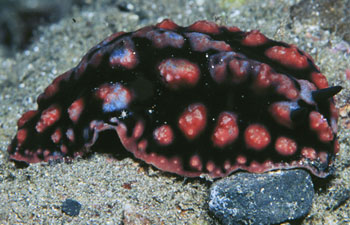
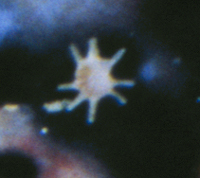
Hi Bill,
I have this slide in my Phyllidiella pustulosa file, but I am not sure it is. The rhinophores are lamellate. I enlarged the image and tried to count the lamella. I don't know the standard way to count lamella, but it looks like about 17 to me. It has a foram riding just above the arch in the mantle edge. Luadi, Milne Bay, Papua New Guinea, May, 1998. Length: 40 mm, Depth: about 5 meters
Thanks!
Mary Jane
divepng@yahoo.com
Adams, M.J., 2002 (Jul 1) Phyllidiopsis burni from Papua New Guinea. [Message in] Sea Slug Forum. Australian Museum, Sydney. Available from http://www.seaslugforum.net/find/3784Dear Mary Jane,
This is Phyllidiopsis burni. The colour of the animal, and the arrangement of tubercles, fir very well. The 17 rhinophoral lamellae also fit within Brunckhorst's range for this species. It's good to get further records of this species as Brunckhorst had only one record from the Great Barrier Reef, one from Papua New Guinea, and a few from Micronesia.
Best wishes,
Bill Rudman
Phyllidiopsis burni from Christmas Island
May 16, 2002
From: W.B. Rudman


Here are photos of two animals I am identifying as Phyllidiopsis burni from John Hicks' Christmas Island, Indian Ocean collections. As far as I can find this species has not previously been recorded from the Indian Ocean.
PHOTOS: Upper: AM C126505, 13 November 1980, south arm of Cantilever, 7.5m, on coral rock, 46 mm long alive Christmas Is., Indian Ocean.
Lower: AM C126504, 13 November 1980, south arm of Cantilever, 7.5m, on coral rock, 25 mm long alive, Christmas Is., Indian Ocean. Photos: John Hicks
Best wishes,
Bill Rudman
billr@seaslugforum.net
Rudman, W.B. , 2002 (May 16) Phyllidiopsis burni from Christmas Island. [Message in] Sea Slug Forum. Australian Museum, Sydney. Available from http://www.seaslugforum.net/find/6567Phyllidiella pustulosa? from Lady Musgrave Island
February 19, 2001
From: David Harasti
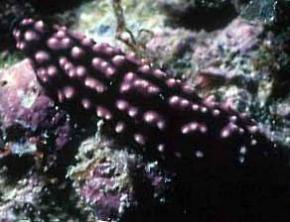
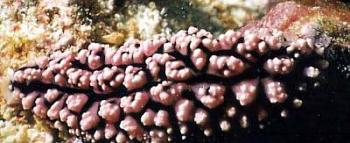
Hi Bill,
These two pictures were taken on Lady Musgrave Island in January of this year. The species was about about 4-5cm in length. Am I correct in assuming it is Phyllidiella pustulosa?
Thanks,
David
davidh@dynamite.com.au
Harasti, D., 2001 (Feb 19) Phyllidiella pustulosa? from Lady Musgrave Island. [Message in] Sea Slug Forum. Australian Museum, Sydney. Available from http://www.seaslugforum.net/find/3752Dear Dave,
The simple answer would be to say yes, but I don't think either of these is P. pustulosa but I am afraid without specimens or further information on the living animals I can't be sure. I suspect that the dark animal in the upper photo is Phyllidiopsis burni and the pink and black animal in the lower photo is Phyllidiopsis fissuratus, but without knowing the colour of the rhinophores or the underside of the animals, or the shape of their oral tentacles, I can only make guesses.
Best wishes,
Bill Rudman
Phyllidiopsis burni from the Marshall Islands
June 15, 2000
From: Scott Johnson
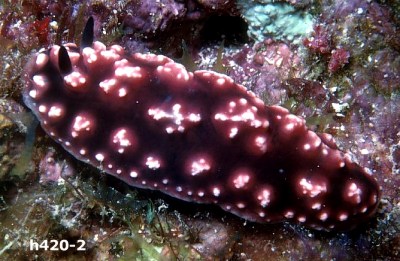
Hi Bill,
Here is a photo of what appears to be Phyllidiopsis burni from Kwajalein in the Marshall Islands. It is pretty rare in this area.
Scott
johnson@kmr.ll.mit.edu
Johnson, S., 2000 (Jun 15) Phyllidiopsis burni from the Marshall Islands. [Message in] Sea Slug Forum. Australian Museum, Sydney. Available from http://www.seaslugforum.net/find/2537Thanks Scott,
From Brunckhorst's review this species is pretty rare but most records are from Guam and other parts of Micronesia.
Best wishes,
Bill Rudman.
Re: Phyllidiella cooraburrama
July 19, 1999
From: Des Paroz
Hi Bill
Some details on the P.cooraburrama. The photo was taken at a depth of approx 35m, in the swimthrough at South Ema Reef, Kimbe Bay (near Walindi Plantation) Papua New Guinea.
Hope this info is useful.
Best regards
Des Paroz
des@paroz.com
Paroz, D., 1999 (Jul 19) Re: Phyllidiella cooraburrama. [Message in] Sea Slug Forum. Australian Museum, Sydney. Available from http://www.seaslugforum.net/find/1080Note added Nov. 2002: I think this is Phyllidiopsis burni - see message .. Bill Rudman
Thanks Des,
Any information like this could be useful.
Best wishes,
Bill Rudman.
Re: Phyllidiella cooraburrama
July 14, 1999
From: Des Paroz
Note added Nov. 2002: I think this is Phyllidiopsis burni - see message .. Bill Rudman
Hi Bill
Just saw the posting on P.cooraburrama on the Sea Slug Forum. I thought this was an interesting find, as it was the one nudibranch I couldn't seem to find anything resembling in any book.
Although I am by no means an expert on the feeding of the nudibranch, it did appear to me that it was feeding on this sponge. This weekend I'll check my records and find out about depths and locations of the photo.
Best regards,
Des
des@paroz.com
Paroz, D., 1999 (Jul 14) Re: Phyllidiella cooraburrama. [Message in] Sea Slug Forum. Australian Museum, Sydney. Available from http://www.seaslugforum.net/find/1066Phyllidiella cooraburrama from Papua New Guinea
July 13, 1999
From: Des Paroz
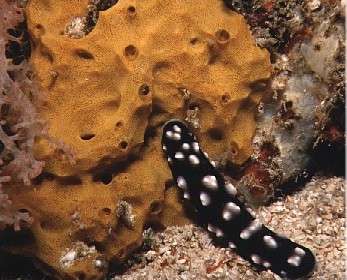
Dear Bill
Here is another nudibranch from Papua New Guinea (Kavieng & Wallindi) May 1999, I would like identified for my DIVESITE at http://www.divesite.paroz.com.
Best regards
Des Paroz
des@paroz.com
Paroz, D., 1999 (Jul 13) Phyllidiella cooraburrama from Papua New Guinea. [Message in] Sea Slug Forum. Australian Museum, Sydney. Available from http://www.seaslugforum.net/find/1036Note added Nov. 2002: I think this is Phyllidiopsis burni - see message .. Bill Rudman
Dear Des,
This is quite an interesting find as I think it is Phyllidiella cooraburrama which was only named a few years ago and hasn't been recorded since. It would be nice to know if the sponge it is crawling off is its food sponge.
Bill Rudman.
